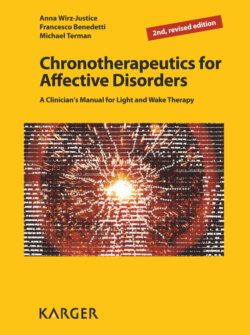Читать книгу Chronotherapeutics for Affective Disorders - M. Terman - Страница 16
На сайте Литреса книга снята с продажи.
1.6 Sleep Deprivation
ОглавлениеOddly enough, when depressed patients stay awake for 36 h, mood does not continue to follow a linear decline as would be extrapolated from figure 9 (right). In healthy subjects, this decline occurs throughout the night, until the next day when the positive surge of the circadian system balances it. In depression, something specific (and different from normal) is triggered by a night’s sleep deprivation that leads to a profound switch in clinical state. Improvement usually begins in the second half of the night or the next day.
Fig. 9. The subjective rating of mood across 24 h in healthy subjects arises from an interaction between a circadian rhythm (left) and prior time spent awake (right) – here separated into the two components by means of a ‘forced desynchrony’ protocol. Redrawn from Boivin et al. [22], with permission.
Many studies have documented antidepressant effects of a variety of manipulations of the sleep-wake cycle, whether of duration (total or partial sleep deprivation) or timing (partial sleep deprivation in the second half of the night, sleep phase advance) [23-26]. The sleep manipulations are summarised in figure 10, which shows clearly that wakefulness in the latter part of the night is the key to an antidepressant response. And it is not light during the night that is inducing the antidepressant response, since patients still improve in darkness (though they find it more difficult to remain awake) [27].
